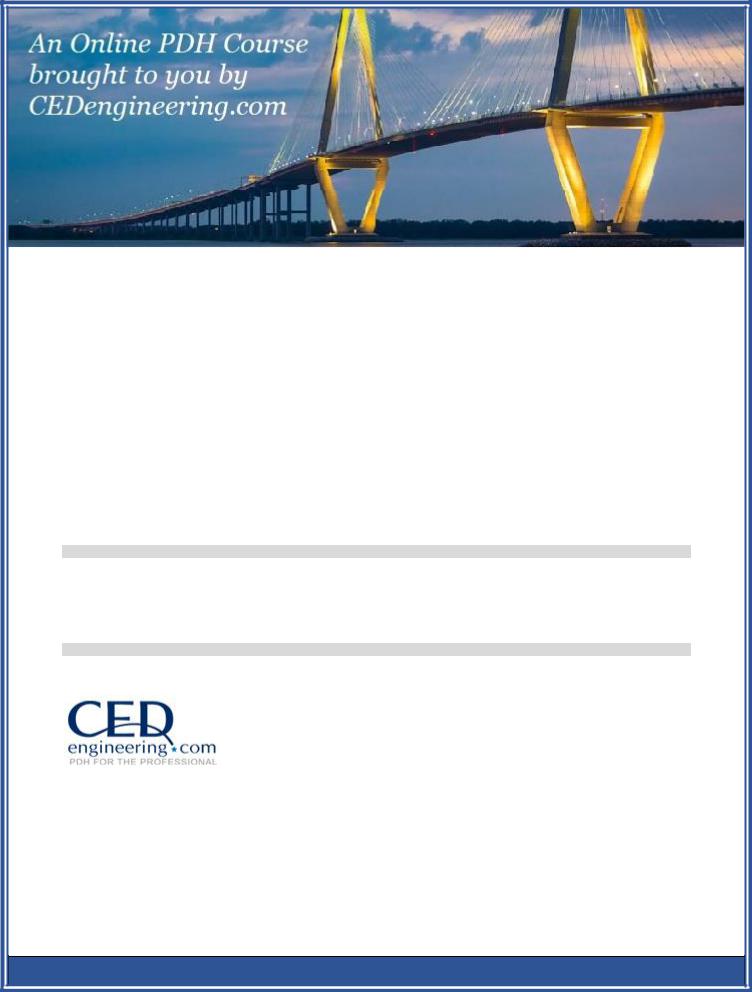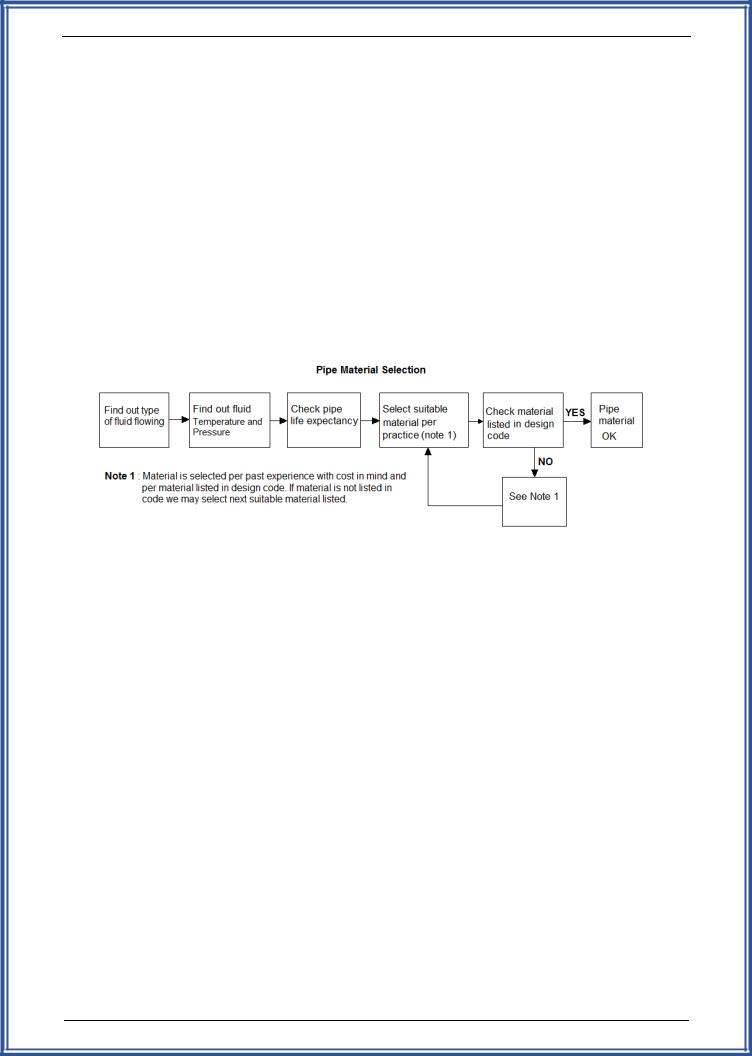
- •CHAPTER - 1
- •PIPING MATERIAL SELECTION & CHARACTERISTICS
- •1. Pipe Material Selection
- •1.1. Selection Criteria
- •1.1.1. Service Life
- •1.1.2. Code Requirements
- •1.1.3. Allowable Stresses
- •1.1.4. Design Temperature
- •1.1.5. Design Pressure
- •1.1.6. Corrosion
- •1.1.7. Economics
- •1.2. Characteristics of Piping Materials
- •1.2.1. Strength
- •1.2.2. Young’s Modulus (Modulus of Elasticity)
- •1.2.3. Stress-Strain Curve
- •1.2.4. Yield Point or Yield strength
- •1.2.5. Ultimate strength
- •1.2.6. Modulus of Elasticity
- •1.2.7. Ductility
- •1.2.8. Malleability
- •1.2.9. Hardness
- •1.2.10. Brittleness
- •1.2.11. Toughness
- •1.2.12. Creep
- •MATERIALS – METALLIC PIPING
- •2. METALLIC PIPES
- •2.1. Piping Material Specifications – ASME/ASTM
- •2.2. ASTM Material Designation
- •2.3. Pipe Grades
- •2.4. Carbon Steel (CS) Pipes
- •Characteristics
- •Applications
- •Standards
- •2.5. Killed Carbon Steel Pipes
- •2.6. Alloy Steel Pipes
- •2.6.1. Low Alloy Steel Characteristics
- •Standards - Pipes
- •2.6.2. High Alloy Steel Characteristics
- •2.7. Chromium Steel Pipes
- •2.8. Stainless Steel Pipes
- •2.8.1. Categories of stainless steels
- •2.8.2. Austenitic Stainless Steels
- •2.8.3. Ferritic Stainless Steel
- •2.8.4. Duplex and Super Duplex Steel
- •2.8.5. Martensitic Stainless Steels
- •2.8.6. Precipitation Hardening Stainless Steel
- •2.9. Cast Iron (CI) Pipes
- •2.10. Nickel and Nickel Alloys
- •2.11. Titanium
- •2.12. Zirconium
- •Some of the common service applications of Zirconium Piping include:
- •2.13. Chrome - Moly
- •2.14. Brass
- •2.15. Aluminium
- •2.16. Copper
- •2.17. Boiler and Heater Tubes
- •CHAPTER - 3
- •SPECIAL PIPING MATERIALS
- •3. PIPING MATERIALS FOR SPECIAL APPLICATIONS
- •3.1. Piping for High Temperature Service
- •3.2. High Temperature Materials
- •3.4. Cold Temperature Materials
- •3.6. Piping for Hydrocarbon Service
- •3.7. Typical Piping Specifications for Various Hydrocarbon Services
- •3.7.2. Sour Water Services
- •3.7.3. Hydrogen Exposure
- •3.7.4. Offshore Environment
- •3.7.5. Sulfides, Sulfurous Gases & Sulfur Environment
- •3.7.6. Oxidation
- •3.7.7. Halogenation Environments
- •3.7.8. Carburizing Environments
- •3.7.9. Nitriding
- •3.7.10. Amine Environment
- •3.7.11. Caustic Environment
- •3.7.12. Corrosion by Acids
- •3.7.13. Corrosion by Salts
- •3.7.14. Chloride Environment
- •3.7.15. Water Corrosion
- •3.7.16. Microbiological Induced Corrosion (MIC)
- •3.8. Applications for Cooling Water and Fire Water Systems
- •3.9. Measures for Corrosion Protection
- •3.9.1. External Corrosion Protection
- •3.10. Material Traceability
- •3.11. Material Test Reports (MTR)
- •3.12. Quality Assurance (QA)
- •3.13. Material Certificates
- •MATERIALS – UNDERGROUND PIPING
- •4. BURIED PIPING
- •4.1. Ductile Iron Pipe
- •4.2. Plastic Pipes
- •4.3. Types of Plastic Pipes
- •4.3.1. Thermoplastics
- •4.3.2. Thermoset Plastics
- •4.4. PVC Pipes
- •4.5. ABS (Acrylonitrile Butadiene Styrene)
- •4.6. Polypropylene (PP) Pipe
- •4.7. Polyethylene (PE) Pipe
- •4.8. PTFE (TEFLON) and PFA Pipe
- •4.9. Plastic Pipe Terminology
- •4.10. Plastic Pipe Designation
- •4.11. Standard Diameters
- •4.12. Dimension Ratio (DR)
- •4.12.1. Standard Dimension Ratio (SDR)
- •4.13. Pressure Rating
- •4.15. Plastic Pipe Standards
- •4.16. HDPE v/s PVC
- •4.17. Standard Sizes
- •4.18. Standard Lengths
- •4.19. Lined Piping
- •4.20. Cost Comparisons

Process Piping Materials – Module 2
Course No: M06-036
Credit: 6 PDH
A. Bhatia
Continuing Education and Development, Inc.
P: (877) 322-5800 info@cedengineering.com
www.cedengineering.com

Process Piping Materials – Module 2 – M06-036
PROCESS PIPING MATERIALS
Pipe materials are selected on the basis of service requirements - most important being the strength, and the corrosion resistance (stability). In making a choice, it is necessary to know what materials are available and to what extent they are suited to the specific application. The decision is quite involved and the choice is significantly affected by the environment and the intended use. Some problems may occur because of distortion and cracking caused by thermal expansion/contraction; typically, a high-temperature alloy might change 4 inch per ft. from ambient to 1,000°C (1,832°F).
This course provides fundamental knowledge of the design and selection of process piping materials. It covers the guidance on the applicable codes and materials. It gives the pertinent information of the most common ASME/ASTM codes and material standards highlighting the applications these are suited for.
This course is the 2nd of a 9-module series that cover the entire gamut of piping engineering. All topics are introduced to the readers with no or limited background on the subject.
The course material is divided into Four (4) distinct chapters as follows:
CHAPTER - 1: PIPING MATERIAL SELECTION & CHARACTERISTICS
This chapter dicusses the selection criteria for piping materials covering service life, temperature, and pressure and corrosion considerations. It presents the characteristics of piping materials required to prevent failures resulting from the environment, normal operation time exposure and upset conditions.
CHAPTER – 2: MATERIALS – METALLIC PIPING
This chapter discusses the most commonly used ASTM material designation standards for Carbon Steel, Stainless Steel, Alloy Steels, Duplex Steel, Cast Iron, Copper, Aluminium, Titanium and other materials. It gives the pertinent information of all relevant ASME/ASTM codes and standards highlighting the applications these are suited for.
i

Process Piping Materials – Module 2 – M06-036
CHAPTER - 3: SPECIAL PIPING MATERIALS
This chapter discusses some specific considerations to piping selection for extreme high and cold temperatures. It provides specific information for hydrocarbon industry and the piping selection issues for mitigating the effects of Wet CO2 corrosion, Hydrogen exposure, Offshore environment, Sulfides and Sulfurous Gases, Halogenation Environments, Carburizing, Nitriding, Sulfur, Amine, Caustic and Chloride environment. Other applications include the cooling water, fire water, sour water services and Microbiological Induced Corrosion (MIC).
CHAPTER – 4: MATERIALS – UNDERGROUND PIPING
This chapter discusses the piping materials for underground services, including ductile iron, concrete pipes, plastic materials such as polyvinyl chloride (PVC), chlorinated polyvinyl chloride (CPVC), fibre reinforced plastic (FRP), reinforced polymer mortar (RPMP), polypropylene (PP), High density polyethylene (HDPE), cross-linked high-density polyethylene (PEX), polybutylene (PB), and acrylonitrile butadiene styrene (ABS).
ii

Process Piping Materials – Module 2 – M06-036
CHAPTER - 1
PIPING MATERIAL SELECTION & CHARACTERISTICS
1. Pipe Material Selection
Appropriate material selection is the cornerstone of pressure equipment and piping design. The primary objective in materials selection is the achievement of metallurgical stability to prevent failure resulting from the environment, normal operation time exposure and upset conditions. The secondary objective is the economy for achievement of the design life by the use of appropriate construction materials.
The process takes the following steps:
1.1.Selection Criteria
The material selection may involve several factors like the high strength requirements combined with high corrosion resistance of the material.
The first step is to understand the plant processes and the environmental conditions to which the plant will be subjected.
•The process information can be obtained from the Process Flow Diagrams (PFD) and Heat and Material Balance spread sheets provided by the Process Engineering Discipline.
•The environmental exposure conditions can be obtained from the basis of the design document.
Once this information is collected, a material selection philosophy is developed and discussed with the owner. When the philosophy is agreed to, the next step is to create Material Selection Diagrams (MSD). Material Selection Diagrams (MSDs) provide a summary of the process loop conditions and the selected materials of construction. Material selection is based on:
3

Process Piping Materials – Module 2 – M06-036
•Fluid composition. A chemical analysis of the produced fluids is generally required for the evaluation of the corrosive components as hydrogen sulfide, carbon dioxide and chlorides. Other components like scaling potential, water content, temperature profile, pressure profile and stresses on the piping and tubulars have to be considered also.
•Economic and practical considerations (purchasing, constructability, etc.) – total installed cost.
•Maximum normal operations pressure, temperature, pH, velocity, dew point, phase, and process fluid composition including contaminants.
•Start-up, shutdown, and upset conditions
•Cyclic service and steam-out operations.
The basis of material selection shall be based on:
1.1.1.Service Life
The service life is the length of time a pipe is estimated to provide adequate performance before maintenance, repair, or replacement. The following are the general guidelines to be considered while designing the systems.
•Alloy steel /stainless steel piping – 20 years’ service life minimum.
•Carbon steel piping – 15 years’ service life minimum.
Corrosion can cause a pipe to deteriorate and shorten its service life.
1.1.2.Code Requirements
The governing Code may depend upon the area where the unit is installed. Power generation applications may fall under the Power Piping Code (ASME B31.1), while units installed in chemical plants or refineries may be covered by the Process Piping Code (ASME B31.3).
1.1.3.Allowable Stresses
The Code sets the pressure and temperature limits for piping materials by tabulating the allowable stresses. The designer uses these stresses to determine the size and thickness of the pipe used.
4

Process Piping Materials – Module 2 – M06-036
1.1.4.Design Temperature
The design temperature of the fluid in the piping is generally assumed the highest temperature of the fluid in the equipment connected with the piping concerned.
Design Temperature is selected based on the Operating Temperature plus some tolerance (usually 25°F as good engineering practice) to allow for system deviation from normal operating conditions.
1.1.5.Design Pressure
The design pressure of the piping system shall be not less than the pressure at the most severe condition of coincidental internal/external pressure and temperature expected during the service life.
Design Pressure is selected based on the Operating Pressure plus some tolerance (usually 30 psi as practice) to allow for system deviation from normal operating conditions.
1.1.6.Corrosion
Corrosion is the destructive attack on a pipe by a chemical reaction with the materials and the environment surrounding the pipe.
Corrosion rates of carbon steel piping are assessed using the Langelier Saturation Index (LSI) and other published corrosion production tools. In low corrosive waters where the flow is stagnant, a 1.5 mm corrosion allowance is adequate, but 3 mm is called out for conservatism in Carbon Steel (CS) piping and equipment.
The potential for corrosion to occur, and the rate at which it will progress, is variable and dependent upon a variety of factors.
•Hydrogen Ion Concentration (pH)
−Corrosion problems can occur when metal pipes are used in locations where the surrounding materials have excessive acidity or alkalinity. The relative acidity of a substance is often expressed by its pH value. The pH scale ranges from 1 to 14, with 1 representing extreme acidity, 14 representing extreme alkalinity, and 7 representing a neutral substance. The closer the pH value is to 7, the less potential the substance has for causing corrosion.
5

Process Piping Materials – Module 2 – M06-036
•Soil Resistivity
−Corrosion is an electrolytic process. As a result, it has the greatest potential of causing damage in soils that have a relatively high ability to pass electric current. The ability of a soil to convey current is expressed as its resistivity in ohms-cm, and a soil with a low resistivity has a greater ability to conduct electricity.
−The greater the resistivity of the soil, the less capable the soil is of conducting the electricity and the lower the corrosion potential. Resistivity values in excess of about 5000 ohm-cm are considered to present limited corrosion potential. Resistivity’s below the range of 1000 to 3000 ohm-cm will usually require some level of pipe protection, depending upon the corresponding pH level (example if pH < 5.0, enhanced pipe protection may be needed for resistivity’s below 3000 ohm-cm, if pH >6.5, enhanced pipe protection may not be needed unless resistivity’s are below 1500 ohm-cm). As a comparative measure, resistivity of seawater is in the range of 25 ohm-cm, clay soils range from approximately 750-2000 ohm-cm. Soils that are of more granular nature exhibit even higher resistivity.
•Chlorides
−Corrosion potential increases in the presence of the chloride ion. Chlorides attacks reinforced steel in concrete, if the concrete cover is inadequate for 300 series stainless steel pipes.
•Lime
−Corrosion can also be caused by surrounding materials such as lime treated base, portland cement concrete and other materials. This corrosion can be prevented by isolating the pipe from its surroundings using coatings or other means.
•Sulfates
−Sulfates are in abundance in Oil, Gas and Chemical plants, which combine with oxygen and water (moisture) to form sulfuric acid. High concentrations can lower the pH value and be of concern to metal pipes and even more damaging to concrete.
6
